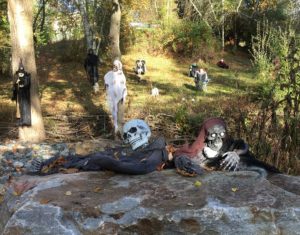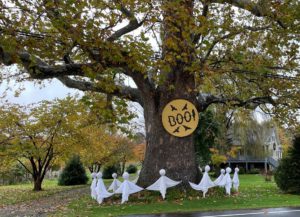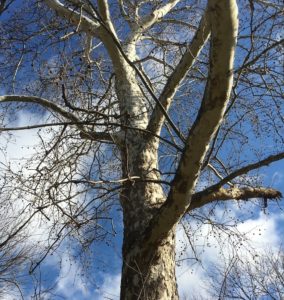Hello fellow readers, How fun to see Halloween enthusiasts decorating their homes like Christmas with purple and orange lights, cobwebs, and spiders. Even smoke machines, reminiscent of the disco days. Skeletons, goblins, and ghosts adorned a front yard we came upon; some were hanging from ropes, and others were hidden behind rocks. Jolee barked a warning, which she rarely does. She usually opts to pull me towards folks to say hello. But these folks were too scary. Where did the gruesome side of Halloween originate? I thought to myself, preferring happy jack-o’-lanterns and corn stalks. Jolly ghosts are fine, too – like the ones circling a massive Sycamore Tree on Route 519 in Hope, NJ. And so, on with the research cap.

Jolee normally pulls me to say hello, but these folks were too scary.
The History of Halloween

Sycamore Ghosts in Hope Township, NJ
Halloween originated 2,000 years ago with the Celts, who lived in what is now Ireland, the United Kingdom, and northern France. They celebrated November 1st as their New Year— a day that marked the harvest and the beginning of winter. Yet winter was associated with death due to the struggle of living through long cold months with very little food.
They held a festival of Samhain (pronounced sow-in) from sunset on October 31st to sundown the following day. The night of the 31st is when they believed the spirits of the dead returned, so they set places at their tables to invite them home. They dressed in disguise, mostly in mummy-like costumes, and visited neighbors reciting verses in exchange for food such as nuts and apples. They believed the presence of spirits helped the priests predict the future, which served as comfort in facing the harsh winter ahead.
The Celtic celebrations found their way into Christianity in the eighth century when Pope Gregory III named November 1st a day to honor saints. It morphed into All Saints’ Day and integrated some Celtic celebration traditions. The evening before was first called All Hallows’ Eve and later Halloween. Somehow Halloween shifted to a secular holiday, and the nuts and apples turned into candy. Perhaps a strategy of candy companies, but all in good fun.
Areas not local to us have Halloween in the Garden events held at Public Gardens or Garden Centers—a clever way to introduce young folks to gardening fun. Maybe we can start a trend around here and pass out bulbs as a treat along with the candy. There’s still time to plant spring flowering bulbs, after all (smile).

Sycamore Trees – “Ghosts of the Forest”
Sycamores – Ghosts of the Forest
Back to the magnificent Sycamore in Hope— there are legends dating back to Egyptian times where the Holy Sycamore reaching the heavens connected the dead with the living world. American Sycamore, Platanus occidentalis, is one of our largest hardwood trees, growing 80 to over 100 ft. tall with massive trunks and beefy crooked branches easy to see through the open canopy. They thrive best in deep moist soil (acidic, neutral, or alkaline), grow quickly, and tolerate wetness and drought in zones 4-9.
As they mature, plates of bark peel off, revealing creamy white, grey, and greenish patches. They are stunning! Native Americans called them Ghosts of the Forest. Perhaps that is why the grand Sycamore in Hope sports a wooden pumpkin poster that reads “Boo.” Happy Halloween.
Garden Dilemmas? AskMaryStone@gmail.com and your favorite Podcast App.
There’s more of the story in Episode 80 of the Garden Dilemmas Podcast:
A related column you’ll enjoy – The Legend of Marigolds and the Day of the Dead.


